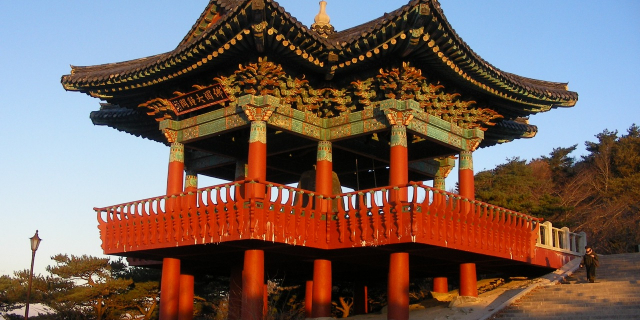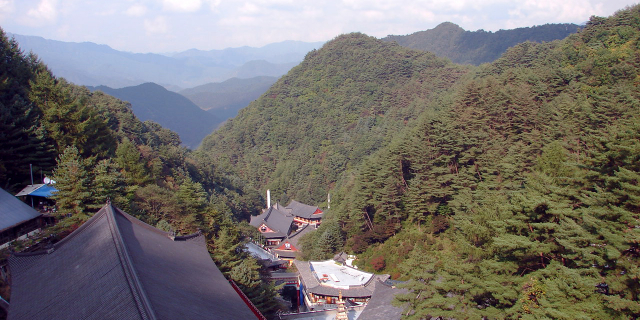The Tripiṭaka Koreana (lit. Goryeo Tripiṭaka) or Palman Daejanggyeong ("Eighty-Thousand Tripiṭaka") is a Korean collection of the Tripiṭaka (Buddhist scriptures, and the Sanskrit word for "three baskets"), carved onto 81,258 wooden printing blocks in the 13th century.
It is the oldest intact version of Buddhist canon in Hanja script. It contains 1,496 titles, divided into 6,568 books, spanning 81,258 pages, for a total 52,330,152 Hanja characters.
Each wood block (page) measures 24 centimetres in height and 70 centimetres (9.4 in × 27.6 in) in length. The thickness of the blocks ranges from 2.6 to 4 centimetres (1.0–1.6 in) and each weighs about three to four kilograms (6.6...Read more
The Tripiṭaka Koreana (lit. Goryeo Tripiṭaka) or Palman Daejanggyeong ("Eighty-Thousand Tripiṭaka") is a Korean collection of the Tripiṭaka (Buddhist scriptures, and the Sanskrit word for "three baskets"), carved onto 81,258 wooden printing blocks in the 13th century.
It is the oldest intact version of Buddhist canon in Hanja script. It contains 1,496 titles, divided into 6,568 books, spanning 81,258 pages, for a total 52,330,152 Hanja characters.
Each wood block (page) measures 24 centimetres in height and 70 centimetres (9.4 in × 27.6 in) in length. The thickness of the blocks ranges from 2.6 to 4 centimetres (1.0–1.6 in) and each weighs about three to four kilograms (6.61 - 8.81 lbs). The woodblocks would be almost as tall as Mount Baekdu at 2.74 km (1.70 mi) if stacked and would measure 60 km (37 mi) long if lined up, and weigh 280 tons in total. The woodblocks are in pristine condition without warping or deformation despite being created more than 750 years ago. The Tripiṭaka Koreana is stored in Haeinsa, a Buddhist temple in South Gyeongsang Province, in South Korea.
There is a movement by scholars to change the English name of the Tripiṭaka Koreana. Professor Robert Buswell Jr., a leading scholar of Korean Buddhism, called for the renaming of the Tripiṭaka Koreana to the Korean Buddhist Canon, indicating that the current nomenclature is misleading because the Tripiṭaka Koreana is much greater in scale than the actual Tripiṭaka, and includes much additional content such as travelogues, Sanskrit and Chinese dictionaries, and biographies of monks and nuns.
The Tripiṭaka was designated a National Treasure of South Korea in 1962, and inscribed in the UNESCO Memory of the World Register in 2007. Haeinsa has decided to open the Palman Daejanggyeong, which was limited to Buddhist events, to pre-booked members of the public every weekend, morning and afternoon from 19 June 2021.
 Tripiṭaka Koreana sutra page in 1371
Tripiṭaka Koreana sutra page in 1371 Tripitaka storage
Tripitaka storageThe name Goryeo Tripiṭaka comes from "Goryeo", the name of Korea from the 10th to the 14th centuries.
Work on the first Tripiṭaka Koreana began in 1011 during the Goryeo–Khitan War and was completed in 1087.[1] Choi's Goryeo Military Regime, which moved the capital to Ganghwa Island due to Mongol invasions, set up a temporary organization called "Daejang Dogam".
The act of carving the woodblocks was considered to be a way of bringing about a change in fortune by invoking the Buddha's help.[2][3] The first Tripiṭaka Koreana was based primarily on the Northern Song Tripiṭaka completed in the 10th century,[4][3] but other scriptures published until then, such as the Khitan Tripiṭaka, were also consulted in order to identify items in need of revision and adjustment.[1] The first Tripiṭaka Koreana contained around 6,000 volumes.[1]
The original set of woodblocks was destroyed by fire during the Mongol invasions of Korea in 1232, when Goryeo's capital was moved to Ganghwa Island during nearly three decades of Mongol incursions, although scattered parts of its prints still remain. To once again implore divine assistance with combating the Mongol threat, King Gojong thereafter ordered the revision and re-creation of the Tripiṭaka; the carving began in 1237 and was completed in 12 years,[5] with support from Choe U and his son Choe Hang,[6] and involving monks from both the Seon and Gyo schools. This second version is usually what is meant by the Tripiṭaka Koreana.[7] In 1398, it was moved to Haeinsa, where it has remained housed in four buildings.
The production of the Tripiṭaka Koreana was an enormous national commitment of money and manpower, according to Robert Buswell Jr., perhaps comparable to the US 1960s Apollo program Moon landings.[8] Thousands of scholars and craftsmen were employed in this massive project.[7]
































Add new comment